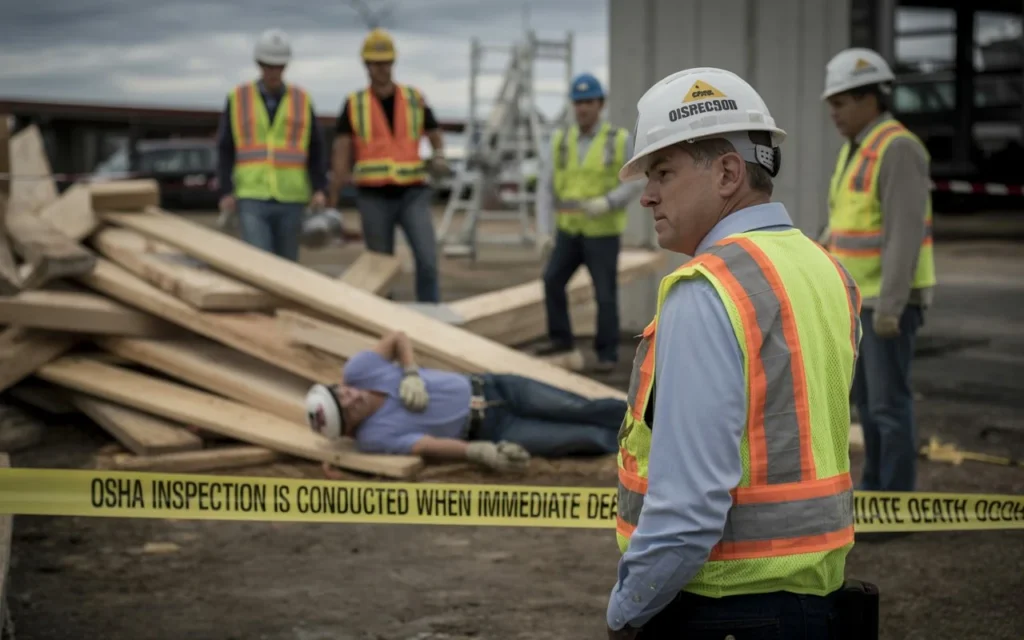When a workplace accident occurs—particularly a fatal one—an OSHA inspection becomes necessary. Such inspections are not formalities; they are vital for life-saving interventions. In the USA, the jurisdiction of OSHA (Occupational Safety and Health Administration) covers such inspections and is bound by strict federal guidelines. Every inspection—whether it’s a fatality, imminent danger, or a serious injury—has its purpose and contributes towards workplace regulation enforcement. Understanding the OSHA accident investigation process allows employers to prepare for audits and ensures compliance which in turn protects employees from potential life-threatening repeated hazards.
Why OSHA Inspections Matter
OSHA inspections are important to ensure safety in any workplace in the United States. These evaluations help to identify potential hazards, check adherence to policies, and prevent accidents in advance. For major incidents such as a workplace death, OSHA conducts a focused fatality inspection to understand the major contributing factors. Understanding the various types of OSHA inspections and the OSHA accident investigation framework can assist both employees and employers in anticipating what to expect. OSHA has specific guidelines on reporting workplace fatalities which these inspections adhere to. Knowing OSHA’s timelines after an inspection allows businesses to plan safety improvements while staying compliant, thus protecting lives.
Types of OSHA Inspections: A Quick Overview
An OSHA inspection is categorized into different types as per the scenario at hand. Programmed, complaint, and unprogrammed inspections are defined as the most basic types. There is also a special type of inspection done in the case of a death which is termed a fatality OSHA inspection. This inspection is conducted with a focus on uncovering the details surrounding a death.
Two more types focus on OSHA imminent danger inspections and severe injury examinations. These categories, although different, contribute greatly in assuring safety at the workplace. Take for example an imminent danger inspection – this type is focused on assessing a situation where there is danger to workers even in the absence of loss of life. Every type of OSHA inspection when understood helps prepare for the arrival of OSHA.
What OSHA Inspection Follows an Immediate Death?
The very moment a death occurs, OSHA conducts a fatality or catastrophe inspection. It is an exhaustive examination that aims to provide an explanation for the workplace deaths. The goal set by OSHA is to control the area, collect data, and enforce relevant laws that would bring about the necessary changes to avert such deaths in the future. The fatality inspections are performed within a few hours post the incident.
This inspection is different from a complaint inspection because it is triggered by an immediate issue. OSHA is very careful with the processes they follow when investigating work-related deaths. They conduct interviews, visit relevant sites, and review documents. If safety regulations are found to have been violated, OSHA often issues citations and fines based on the results. OSHA’s swift actions in these matters demonstrate the importance placed on workplace fatalities.
Step-by-Step Process of a Fatality OSHA Inspection
The OSHA accident investigation process after a death starts with notification. Employers or witnesses must report the death within eight hours. Once OSHA is informed, inspectors arrive at the scene, often within a day, to begin their OSHA site inspection for fatality. They document the accident scene, collect physical evidence, and interview witnesses.
Next, OSHA inspectors analyze the information to identify violations of safety rules. This part of the process is called the OSHA accident scene investigation. Inspectors use an OSHA investigation checklist for deaths to cover all critical aspects. After the investigation, OSHA issues citations if violations are found and sets deadlines for corrective actions. The entire OSHA inspection timeline after fatality can take weeks or months depending on case complexity.
Employer and Employee Rights During Fatality OSHA Inspections
During a fatality inspection, employers must cooperate fully with OSHA. They have the right to ask questions and understand the investigation steps. Employers are responsible for providing access to the site, records, and employees. However, they must also be careful not to interfere with the process. Transparency helps reduce OSHA enforcement inspection after death risks.
Employees have rights too. They can speak to OSHA inspectors confidentially and report hazards without fear of retaliation. Workers should know about OSHA workplace fatality reporting requirements so they can help improve safety. Knowing your rights during an OSHA on-site inspection process protects both workers and employers.
Common Violations Found in Fatality OSHA Inspections
OSHA often finds recurring safety violations during fatality inspections. These include failure to provide proper protective equipment, lack of fall protection, poor machine guarding, and inadequate training. Violations related to hazardous materials and electrical safety are also common. These issues show up repeatedly in OSHA serious injury investigation reports.
Citations resulting from these violations can be severe. OSHA issues fines and mandates corrective actions under OSHA inspection standards for fatal injuries. Employers must learn from these findings to prevent future incidents. The data also helps OSHA improve its workplace fatality protocols and inspection priorities.
OSHA Training: Preventing Fatalities Before They Happen
One of the best ways to prevent workplace deaths is through OSHA training. Courses like the OSHA 30 Hour Construction training teach workers and supervisors how to recognize hazards and follow safety rules. Many prefer the OSHA 30 Online course for its convenience. These training programs improve awareness and reduce accident risks.
Investing in OSHA 30 certification can be affordable, considering the OSHA 30 certification cost. This training is a smart step to avoid costly accidents and inspections later. For more detailed information on OSHA training, Proper training builds a culture of safety that stops fatal accidents before they start. You can also visit Get OSHA Courses to see their latest OSHA certifications for construction and general industry training.
How to Prepare for an OSHA Inspection to Prevent Fatalities
Effective planning plays a vital role in successfully navigating OSHA inspections as well as avoiding fatalities. It is recommended that employers actively engage in conducting comprehensive audits as well as OSHA safety drills and maintaining thorough documentation, especially after a workplace fatality. Active maintenance of tidy workplaces that are devoid of potential hazards coupled with continuous training on safety reinforces these efforts. Following and using the OSHA death investigation checklist can help proactively determine risks and issues before they become severe.
Also, employers should know how to handle an inspection calmly and professionally. Preparing employees for OSHA visits reduces confusion and increases cooperation. Staying up-to-date with OSHA’s inspection criteria for fatalities and following Federal OSHA death inspection rules ensures readiness. A prepared workplace is a safer workplace.
The Critical Role of OSHA Inspections in Saving Lives
In conclusion, OSHA inspections following an immediate death play a vital role in protecting workers. The thorough OSHA fatality inspections identify hazards and enforce compliance to prevent future tragedies. Employers, employees, and safety managers should understand the inspection process and rights involved.
By focusing on training, preparation, and transparency, workplaces can reduce fatal accidents. OSHA’s strict workplace death protocols and enforcement help create safer environments across the country. The value of OSHA inspections goes beyond penalties—they save lives.
| OSHA Inspection Type | Purpose | Trigger | Response Time |
| Programmed Inspection | Routine checks based on data | Scheduled | Scheduled |
| Complaint Inspection | Investigate worker complaints | Worker reports | Varies |
| Fatality Inspection | Investigate workplace deaths | Immediate death report | Within 24 hours |
| Imminent Danger | Address immediate risks to workers | Serious hazard reported | Immediate |
| Severe Injury | Investigate serious injuries | Hospitalization or amputation | Within 24 hours |
FAQ’s
What does an OSHA inspection consist of?
An OSHA inspection checks the site for safety violations, conducts interviews with staff, analyzes documents, and reviews employee safety records. This type of inspection centers on compliance enforcement and incident root cause analysis.
What are the 5 types of OSHA inspections?
Workplace events can trigger five main types – programmed inspections, complaint inspections, fatality or catastrophe inspections, imminent danger inspections, and severe injury inspections. These events range from complaints to more serious occurrences, like workplace fatalities.
What are OSHA requirements for construction?
OSHA mandates employers to maintain basic safety standards, risk communication, personal protective equipment, promptly report serious injuries, and provide a safe construction site. Also to issue hazard communication and fall protection.



